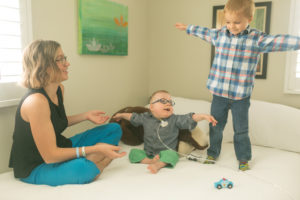Have you ever wondered if your child with specialized medical needs qualifies for home care? At MGA, it’s our goal to educate families on in-home opportunities and provide the best possible care.
We are often asked questions regarding the process for qualifying and starting home care services. That’s why we spoke with Austin Gray, Director of Business Development – Phoenix, to break down the onboarding process and give an inside look at becoming an MGA family.
An Introduction to Home Care
We want all of our families to have an understanding of how pediatric in-home services can help make daily living a little easier. MGA Homecare provides a variety of services for children with intricate medical needs, such as:
– Pediatric private duty nursing (PDN)
– Intermittent nursing visits
– Certified nursing assistant (CNA) care
– Physical therapy, occupational therapy and speech-language pathology (certain locations)
We focus on helping our patients at each stage of childhood. Your child may be eligible for in-home support if he or she is between 0-21 years old and has medicinal or therapeutic complexities that require continuous care. Children qualify for nursing or aide services based on a variety of conditions. It’s a good idea to ask about home care if your child has needs such as tracheostomy and/or ventilator, oxygen, pulse ox monitoring, tube feeding, IV/PICC line or limited mobility.
Becoming an MGA Family
Our goal is to make the process of gaining an in-home clinician as smooth as possible. We know it’s a big change, so we strive to make your transition from hospital to home straight forward and simple.
Our interviewee, Austin, is one of the first people our Phoenix families meet when beginning their MGA journey. From the start, he works alongside families to match needs with care. Here’s what you can expect when you start the process with us:
Q: I’m a parent in the hospital preparing to take my child home, how do I find out more about MGA?
A: In a sense, we come to you. Hospitals typically have what’s called a discharge coordinator and their job is to find families preparing to be discharged and assist in setting up a care plan. Once a discharge coordinator informs MGA Homecare of your situation, we reach out to you directly. You can always call your nearest MGA Homecare office and a team member will be happy to assist you.
Q: Once you know about my situation, how should I expect to hear from you?
A: Before you are discharged, we contact you via phone to talk about your medical and home specifics to determine how we can best provide care. In addition to discussing the medical support needed for your child, this call gives us the opportunity to chat about your home life. To provide the best clinician for your home it’s important for our team to know where you’re located, learn about any special circumstances (such as pets) and understand your family culture.
Q: Will I have a chance to meet an MGA team member in-person before leaving the hospital?
A: Of course. After our initial phone call, a Clinical Case Manager (CCM) meets with you and your child at your facility to dive deeper into specific medical needs. Your CCM assigns your clinician(s), so it’s important to be open and honest about all characteristics and expectations you are looking for in an in-home nurse or therapist.
Q: How many staff members will I have on my home care team?
A: In addition to your CCM, you will also have a Client Service Manager (CSM). A CSM is your ongoing operational service provider. This person handles staffing, scheduling, and any account changes. Your CSM is your main point of contact for questions and concerns while your CCM is the main contact for your clinicians. CCMs handle all things medical and work alongside your clinicians to ensure items such as medications, medical history, and hospital visits are up-to-date. The last and most important piece of your team is your assigned clinician(s).
Q: Now that I have my questions answered, how soon can care services begin?
A: We work hard to start services as soon as possible, but this requires planning and documentation to be completed. The first steps are establishing a primary physician and setting a care plan. A plan of care is written documentation of medication, insurance, treatment type, and skills needed for the care of your child. We recommend having this plan created before the discharge date as it is required to be signed by your primary physician.
Next Steps
Once care has begun, you are officially an MGA family! Setting up our services and support are just the beginning. Stay tuned for part two of our inside look and follow our Facebook page for the latest happenings and news.
Austin Gray is the Director of Business Development in Phoenix. He assists in the transition from facility to home by coordinating at-home nursing services. Austin is the first and primary contact for inpatient families.
“My goal is to be their guide,” said Austin. “I help them navigate the complex discharge landscape and get them set up for success as an MGA family.”



